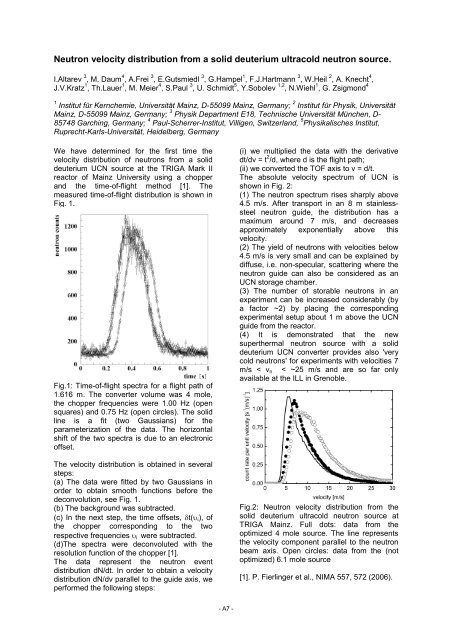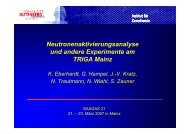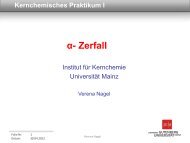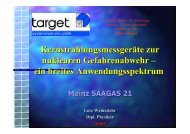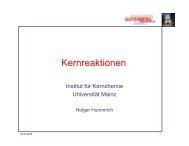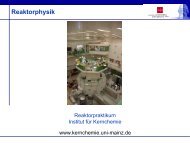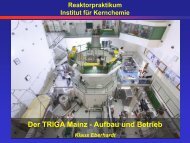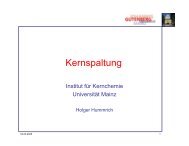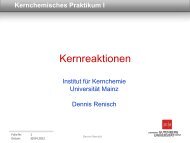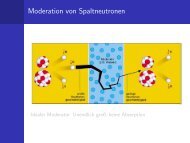jahresbericht 2007 - Institut für Kernchemie - Johannes Gutenberg ...
jahresbericht 2007 - Institut für Kernchemie - Johannes Gutenberg ...
jahresbericht 2007 - Institut für Kernchemie - Johannes Gutenberg ...
Create successful ePaper yourself
Turn your PDF publications into a flip-book with our unique Google optimized e-Paper software.
Neutron velocity distribution from a solid deuterium ultracold neutron source.<br />
I.Altarev 3 , M. Daum 4 , A.Frei 3 , E.Gutsmiedl 3 , G.Hampel 1 , F.J.Hartmann 3 , W.Heil 2 , A. Knecht 4 ,<br />
J.V.Kratz 1 , Th.Lauer 1 , M. Meier 4 , S.Paul 3 , U. Schmidt 5 , Y.Sobolev 1,2 , N.Wiehl 1 , G. Zsigmond 4<br />
1 <strong>Institut</strong> für <strong>Kernchemie</strong>, Universität Mainz, D-55099 Mainz, Germany; 2 <strong>Institut</strong> für Physik, Universität<br />
Mainz, D-55099 Mainz, Germany; 3 Physik Department E18, Technische Universität München, D-<br />
85748 Garching, Germany; 4 Paul-Scherrer-<strong>Institut</strong>, Villigen, Switzerland, 5 Physikalisches <strong>Institut</strong>,<br />
Ruprecht-Karls-Universität, Heidelberg, Germany<br />
We have determined for the first time the<br />
velocity distribution of neutrons from a solid<br />
deuterium UCN source at the TRIGA Mark II<br />
reactor of Mainz University using a chopper<br />
and the time-of-flight method [1]. The<br />
measured time-of-flight distribution is shown in<br />
Fig. 1.<br />
Fig.1: Time-of-flight spectra for a flight path of<br />
1.616 m. The converter volume was 4 mole,<br />
the chopper frequencies were 1.00 Hz (open<br />
squares) and 0.75 Hz (open circles). The solid<br />
line is a fit (two Gaussians) for the<br />
parameterization of the data. The horizontal<br />
shift of the two spectra is due to an electronic<br />
offset.<br />
The velocity distribution is obtained in several<br />
steps:<br />
(a) The data were fitted by two Gaussians in<br />
order to obtain smooth functions before the<br />
deconvolution, see Fig. 1.<br />
(b) The background was subtracted.<br />
(c) In the next step, the time offsets, δt(υ i ), of<br />
the chopper corresponding to the two<br />
respective frequencies υ i were subtracted.<br />
(d)The spectra were deconvoluted with the<br />
resolution function of the chopper [1].<br />
The data represent the neutron event<br />
distribution dN/dt. In order to obtain a velocity<br />
distribution dN/dv parallel to the guide axis, we<br />
performed the following steps:<br />
(i) we multiplied the data with the derivative<br />
dt/dv = t 2 /d, where d is the flight path;<br />
(ii) we converted the TOF axis to v = d/t.<br />
The absolute velocity spectrum of UCN is<br />
shown in Fig. 2:<br />
(1) The neutron spectrum rises sharply above<br />
4.5 m/s. After transport in an 8 m stainlesssteel<br />
neutron guide, the distribution has a<br />
maximum around 7 m/s, and decreases<br />
approximately exponentially above this<br />
velocity.<br />
(2) The yield of neutrons with velocities below<br />
4.5 m/s is very small and can be explained by<br />
diffuse, i.e. non-specular, scattering where the<br />
neutron guide can also be considered as an<br />
UCN storage chamber.<br />
(3) The number of storable neutrons in an<br />
experiment can be increased considerably (by<br />
a factor ~2) by placing the corresponding<br />
experimental setup about 1 m above the UCN<br />
guide from the reactor.<br />
(4) It is demonstrated that the new<br />
superthermal neutron source with a solid<br />
deuterium UCN converter provides also 'very<br />
cold neutrons' for experiments with velocities 7<br />
m/s < v n < ~25 m/s and are so far only<br />
available at the ILL in Grenoble.<br />
Fig.2: Neutron velocity distribution from the<br />
solid deuterium ultracold neutron source at<br />
TRIGA Mainz. Full dots: data from the<br />
optimized 4 mole source. The line represents<br />
the velocity component parallel to the neutron<br />
beam axis. Open circles: data from the (not<br />
optimized) 6.1 mole source<br />
[1]. P. Fierlinger et al., NIMA 557, 572 (2006).<br />
- A7 -


